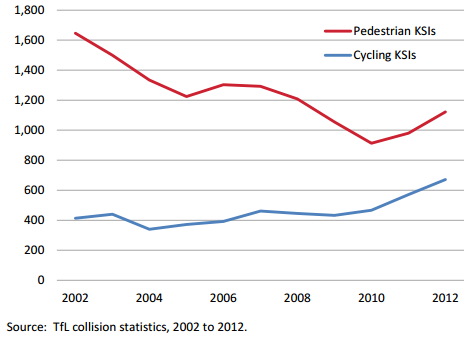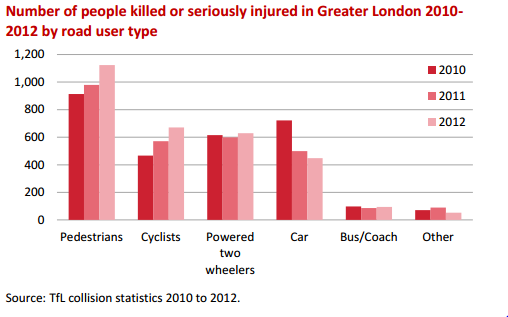A London Assembly study has highlighted the increasing vulnerability of pedestrians in London and is critical of the policies of the Mayor of London and Metropolitan Police.
Feet First: Improving Pedestrian Safety in London is a newly published report by the Assembly's Transport Committee, which comprises members from the Conservative, Labour, Liberal Democratic and Green parties.
In their executive summary the Committee set out the current state of affairs:
More pedestrians are killed or seriously injured on London’s streets than any other type of road user. After a decade of progress in reducing pedestrian casualties, there are worrying signs that this progress may be halting.... Increased levels of walking would have significant health and economic benefits for London, reducing pressure on public transport and improving air quality, but fear of road danger is a major barrier to encouraging more people to take to their feet.
Among many points made by the report the following stand out:
- there is a tacit assumption that a certain level of road deaths is tolerable
- the Mayor of London's policies have jeopardizeds the safety of pedestrians
- 20mph speed limits sharply reduce deaths and serious injuries across all road user groups
- road crime, such as red light jumping, speeding and use of mobile phones, is real crime and should be treated as such.

The Committee criticizes the Mayor of London's policy with regard to road accidents. The Mayor has set a target of a 40 per cent reduction in total casualties by 2020, which might be seen as a tacit acceptance that a certain level of road deaths is inevitable and "tolerable". They contrast this with the Vision Zero policy adopted by the Mayor of New York, aimed at a complete end to road deaths and injuries in his city. One of the key principles of Vision Zero is that "human life and health take priority over mobility and other objectives of the transport system".

Until 2010 "green man time" was calculated on the basis of a walking speed of 0.8 metres per second. Since 2010 a speed of 1.2 metres per second has been used. However, research by University College London has established that almost 70 per cent of people aged over 65 walk at a slower pace than this.
The Committee is strongly in favour of 20mph speed limits. It points out that:
In 2012, 147 collisions occurred on roads with a speed limit of 20mph or lower, compared with over 22,000 collisions on roads with higher speed limits. A TfL review of 20mph zones concluded that they reduced deaths and serious injuries across all road user groups by 53 per cent.
The report calls on the Police and courts to take driving offences more seriously. In a list of their agreed priorities, 22 of the Met’s 32 borough safer transport teams listed cycle thefts - but not one listed traffic law enforcement, which is clearly a much more important police role. Evidence from Operation Safeway suggests that visible enforcement measures are highly effective in reducing traffic offences. The members are dismayed by the low prosecution and conviction rates for road traffic offences in which a pedestrian is killed or seriously injured. Merely trying to "educate" drivers is insufficient, effective enforcement is essential. However, even at pedestrian injury blackspots there are no plans to install safety cameras.



